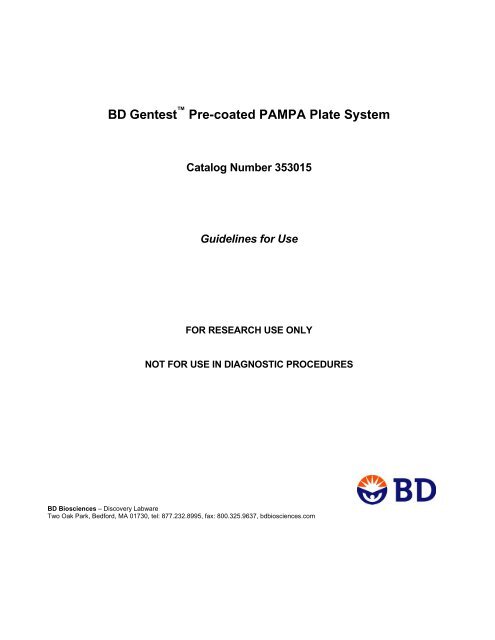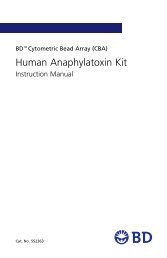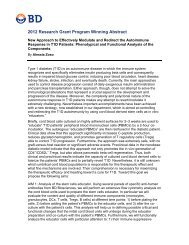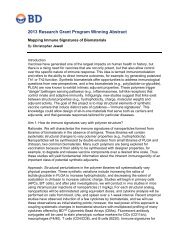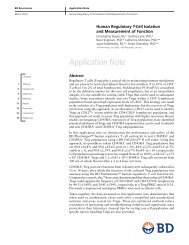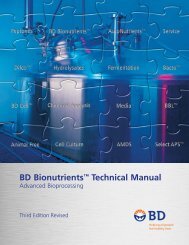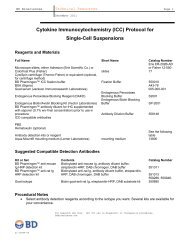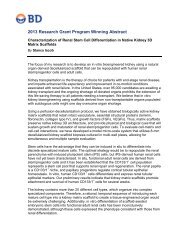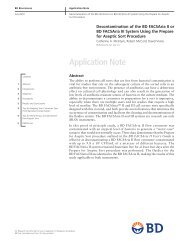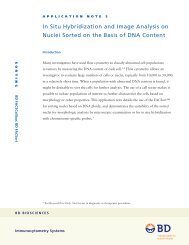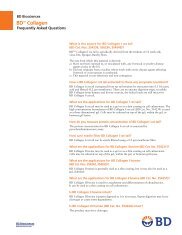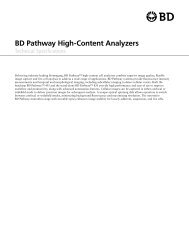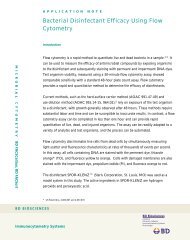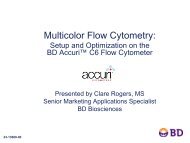BD Gentest Pre-coated PAMPA Plate System - BD Biosciences
BD Gentest Pre-coated PAMPA Plate System - BD Biosciences
BD Gentest Pre-coated PAMPA Plate System - BD Biosciences
You also want an ePaper? Increase the reach of your titles
YUMPU automatically turns print PDFs into web optimized ePapers that Google loves.
<strong>BD</strong> <strong>Gentest</strong> <strong>Pre</strong>-<strong>coated</strong> <strong>PAMPA</strong> <strong>Plate</strong> <strong>System</strong><br />
Catalog Number 353015<br />
Guidelines for Use<br />
FOR RESEARCH USE ONLY<br />
NOT FOR USE IN DIAGNOSTIC PROCEDURES<br />
<strong>BD</strong> <strong>Biosciences</strong> – Discovery Labware<br />
Two Oak Park, Bedford, MA 01730, tel: 877.232.8995, fax: 800.325.9637, bdbiosciences.com
SPC-353015-G rev 1.0 Page 2<br />
Introduction<br />
<strong>BD</strong> <strong>Gentest</strong> <strong>Pre</strong>-Coated <strong>PAMPA</strong> <strong>Plate</strong> <strong>System</strong><br />
Drug compounds are screened for their oral absorption potential early in the drug<br />
discovery process in order to eliminate poor performers and to identify candidates that<br />
need to be modified. Parallel artificial membrane permeability assays (<strong>PAMPA</strong>) have<br />
become a very useful tool for predicting in vivo drug permeability and are well-suited as<br />
a ranking tool for the assessment of compounds with passive transport mechanisms.<br />
Use of the <strong>PAMPA</strong> assay allows for ranking of compounds into a low or high<br />
classification by using UV VIS spectroscopy or LC/MS.<br />
The <strong>BD</strong> <strong>Gentest</strong> <strong>Pre</strong>-Coated <strong>PAMPA</strong> <strong>Plate</strong> <strong>System</strong> is a 96-well insert system with a<br />
PVDF filter plate which has been pre-<strong>coated</strong> with structured layers of phospholipids and<br />
a matched receiver microplate. The <strong>BD</strong> <strong>Gentest</strong> <strong>Pre</strong>-Coated <strong>PAMPA</strong> <strong>Plate</strong> <strong>System</strong><br />
has been validated for use in <strong>PAMPA</strong> and comes ready to use in your assay.<br />
Each pair of filter plate and receiver plate is individually packaged in a foil bag. Store<br />
the package at –20°C immediately upon receipt.<br />
.<br />
Recommended Procedure for Permeability Assay<br />
Step 1: Prior to use, the pre-<strong>coated</strong> <strong>PAMPA</strong> plate system should be warmed to room<br />
temperature for at least 30 minutes. While the plate system is warming, the compound<br />
solutions can be prepared by diluting stock solutions into a buffer (e.g. PBS).<br />
Note: Once a pre-<strong>coated</strong> <strong>PAMPA</strong> plate is warmed to room temperature, it must be<br />
used within 24 hours.<br />
Step 2: Add 300 μL of compound solutions (e.g. 100 – 200 μM in PBS) per well in the<br />
receiver plate (donor plate).<br />
Step 3: Add 200 μL of buffer (e.g. PBS) per well in the filter plate (acceptor plate).<br />
Step 4: Place the filter plate on the receiver plate by slowly lowering the pre-<strong>coated</strong> <strong>PAMPA</strong><br />
plate until it sits on the receiver plate. Incubate the assembly at room temp for 5 hours.<br />
Step 5: Separate the pre-<strong>coated</strong> <strong>PAMPA</strong> plate and the receiver plate. Determine the compound<br />
concentrations in both plates using UV VIS spectroscopy or LC/MS. Calculate the<br />
permeability of each compound using the formula listed in the next section.<br />
.
SPC-353015-G rev 1.0 Page 3<br />
Recommended Formula for Data Analysis<br />
Permeability (in unit of cm/s):<br />
− ln[ 1−<br />
C A ( t)<br />
/ Cequilibrium<br />
]<br />
Pe<br />
=<br />
A∗<br />
( 1/<br />
V + 1/<br />
V ) ∗t<br />
Mass Retention:<br />
D<br />
R = 1− [ CD<br />
( t)<br />
∗VD<br />
+ C A ( t)<br />
∗V<br />
A ] /( C0<br />
∗VD<br />
)<br />
Where:<br />
A<br />
C0 = initial compound concentration in donor well (mM)<br />
CD (t) = compound concentration in donor well at time t. (mM)<br />
CA (t) = compound concentration in acceptor well at time t. (mM)<br />
VD = donor well volume = 0.3 mL<br />
VA = acceptor well volume = 0.2 mL<br />
C equilibrium<br />
= [ CD<br />
( t)<br />
∗VD<br />
+ C A ( t)<br />
∗V<br />
A ] /( VD<br />
+ VA<br />
)<br />
A = filter area = 0.3 cm 2<br />
t = incubation time = 18000 s (= 5 hr)<br />
Example:<br />
If the initial concentration and final concentrations (at 5 hr) of a compound are measure<br />
to be<br />
C0<br />
= 200 μM<br />
CD (t) = 180 μM<br />
CA (t) = 10 μM<br />
Then the mass retention and permeability of this compound are<br />
Cequilibrium P e<br />
= [ 180 ∗ 0.<br />
3 + 10 ∗ 0.<br />
2]<br />
/( 0.<br />
3 + 0.<br />
2)<br />
= 112μM<br />
− ln[ 1−<br />
10 / 112]<br />
−6<br />
=<br />
= 2.<br />
078∗10<br />
cm / s<br />
0.<br />
3∗<br />
( 1/<br />
0.<br />
3 + 1/<br />
0.<br />
2)<br />
∗18000<br />
R = 1−<br />
[ 180 ∗ 0.<br />
3 + 10 ∗ 0.<br />
2]<br />
/( 200 ∗ 0.<br />
3)<br />
= 0.067 = 6.7%
SPC-353015-G rev 1.0 Page 4<br />
Note: The permeability equation is deduced from the two-flux equation:<br />
(Avdeef et al., Eur. J. Phar. Sci. 2001, 14, 271-280)<br />
CA(t) = M/(VD+VA) + (CA(0) - M/(VD+VA))exp{-PeA(1/VD+1/VA)t}<br />
M refers to the total amount (mol) of the drug in the system. When there is mass retention, M is replaced<br />
by the total amount minus the amount of sample lost.<br />
Please visit www.bdbiosciences.com/<strong>PAMPA</strong> to download spreadsheets that contain the formula for<br />
calculating permeability.<br />
Product Specifications<br />
Design and Materials:<br />
• Microplate Type<br />
• Filter plate<br />
• Filter plate <strong>PAMPA</strong> coating<br />
• Filter plate lid<br />
• 96 well microplate configuration,<br />
complies with ANSI standards<br />
• Polystyrene with 0.4 μm PVDF<br />
membrane<br />
• Phospholipids<br />
• Polystyrene<br />
• Receiver microplate<br />
• Polystyrene<br />
<strong>Pre</strong>-<strong>coated</strong> filter plate compatibility: • Verified compatibility with 5%<br />
DMSO and 20% methanol<br />
Automation compatibility: • Suitable for use with most liquid<br />
handling equipment<br />
<strong>BD</strong> <strong>Gentest</strong> <strong>Pre</strong>-<strong>coated</strong> <strong>PAMPA</strong> <strong>Plate</strong> • <strong>PAMPA</strong> assay performed using a<br />
system QC:<br />
set of standard compounds


